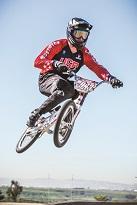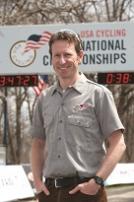

When we talk about locations for cycling events, it’s something that is slightly complicated. We have so many different types of events. There are five disciplines – road, track, mountain bike, BMX and cyclo-cross – and of course, each of those requires a different type of course. Also, within some of those disciplines, there might be multiple subdisciplines. For example, in mountain biking, you have cross-country, short track cross-country, ultra-endurance racing, downhill, dual slalom, four-cross, super D, enduro and observed trials – so for a given competition, you might be looking at any number of events being put on at once, meaning you’re looking for different types of terrain and features. Road racing has seven different subdisciplines, and track racing also has multiple sprint events and endurance events. Of course, you still need access to amenities and services, and you still need all the things any event needs – parking, accommodations, restaurants and so on.
Sometimes, the work of finding a venue is easier. In track cycling, for instance, you need a velodrome, and there are only six or eight of those available to us in the U.S. Road cycling is completely different from that and so are BMX and cyclo-cross. Our website has descriptions of all the different disciplines and descriptions of how they work, and we encourage people to read that and learn more.
Of course, no matter which discipline we’re talking about when it comes to hosting an event, we’re always going to be looking at the quality of the course. That is the most important thing. After all, what you want is a course that is truly going to separate out a deserving national champion.

As mentioned earlier, some disciplines, such as mountain biking, have subdisciplines. At the USA Cycling Mountain Bike National Championships, held this past July, we hosted competition in cross-country, short track cross-country, downhill, dual slalom and our newest event, enduro. All events were held at Mammoth Mountain in California, and because of Mammoth’s size and layout, it was possible for people to travel around and see the different events, as well as to go to the lodge.
Ski resorts are starting to do a lot of summer tourism, so we’re seeing a lot of those places investing in mountain bike infrastructure and making relationships with organizations that put on events because they want to be a destination in their off-season times. Mammoth did a really good job of it. We were able to have a number of events that required completely different layouts and space.
You also have a wide range of ways and reasons people travel to races. You have the athletes who will want to head to a race with their teammates. They will zip in, compete and zip out. They might bring one staff person or a mechanic, but they are not going to come early or stay late.
At the same time, however, you have a lot of the people who say they want to turn their trip into a vacation. They might bring their family, or they might decide to hang out with their friends, if the location is right. Mammoth Mountain was a great example of this – they had good places to eat and plenty of things to do right there, plus if people wanted to extend their trip, they could go hiking, visit Yosemite – all kinds of things. Other good examples of cities where people want to spend time once they compete are Bend, Oregon, and Ogden, Utah. Once you get there, you’re set. You can go fishing, canoeing, whitewater rafting, visiting breweries – there are a lot of good things to do. It becomes a real draw for people who are interested in bringing their families.

USA Cycling markets to convention and visitors bureaus, sports commissions and land owners. When we’re doing our bidding process, we try to sell the economic impact of our events to those groups. In many cases, we’re talking about smaller towns – Mammoth Lakes, Bend and so forth – and when you are coming in for an event with 1,500 participants, it’s definitely a nice big hit for that area. A lot of businesses recognize that, and we’re starting to hear them say they want the event to return.
We have put other events on recently in Columbia County, Georgia, and Madison, Wisconsin, and those areas have truly seen the economic impact of the event. In 2017 and 2018, our Fat Bike Nationals will be in Grand Rapids, Michigan, which is another great example of a town where the event will be able to make a significant impact.
At our cyclo-cross nationals in Austin, Texas, we had 1,600 unique participants. In many cities, people are really looking to get room nights at the times we’re hosting events, so if we can come in and give them an average of 3,500 room nights, that’s something they appreciate. People in the cities notice it too; we were out one night after one of our events, and someone said to us, ‘This is the biggest event I can remember.’
USA Cycling also relies on a lot of partnerships in our chosen cities to make our events successful. Of course, the relationships with the CVBs and sports commissions are always important, and so are the ones with local bicycling clubs. Everyone is interested in having our members come to the city, and we so well aligned with them because we all have common goals.
We offer a special ‘Event Bid Information’ section under the ‘Events’ tab on our website to help folks who are interested in hosting events, and of course, we encourage them to reach out to us.

Our organization sponsors 15 national championships throughout the year in every month except November and December. We also have to be cognizant of what is going on during the calendar year. For example, anything that juniors will participate in can’t be held while school is in session.
A wide range of folks are involved in cycling, and different disciplines can attract different age groups. For example, BMX is a very young sport. Road racing tends to draw participants who are in their thirties, forties and fifties. Mountain biking is very spread out. We see competitors starting at six years old, all the way up to the 80-year-old who was at nationals recently.
The fastest-growing discipline is cyclo-cross. All the races take less than an hour to finish, so nobody has to wait around too long, and organizers can pack a lot of events into one day. It’s very spectator-friendly because it’s on a closed course – and that also means you don’t have to worry about getting permission from the local Department of Transportation or getting the police to direct traffic or worry about a large group of cyclists traveling through the roads. It can take place in the winter, when there’s mud, snow and ice and people think that makes it even more fun. It is one discipline that has really grabbed hold and is getting a lot of attention.
Many cities are marketing their abilities to host cycling. After all, cycling is a fairly high-level demographic and with all the disciplines, there’s bound to be something that cities are interested in hosting, and able to host. USA Cycling has a section on its website where we encourage people to find bicycling clubs in their cities, and where we list our calendar of events. We encourage people to get involved and to help the sport grow.

